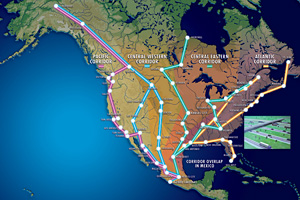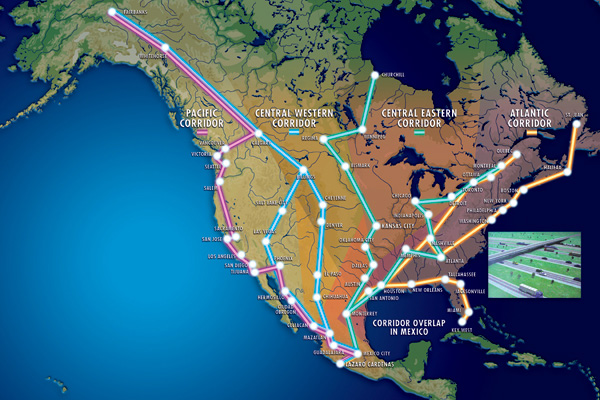 |
 |
 |
 Editorials | Issues | October 2006 Editorials | Issues | October 2006  
Mexico Mega-Port Plan Key to 'NAFTA Superhighways'
 WorldNetDaily.com WorldNetDaily.com


| | This map is a conceptualization of the Super Highways now underway to connect the United States, Canada, and Mexico to help bring about the creation of a North American Union similar to the European Union. (see larger image below) |
There are mixed signals coming from Mexico about the fate of a proposed mega-port in Baja California for mainly Chinese goods that would be shipped on rail lines and "NAFTA superhighways" running through the U.S. to Canada.

The port at Punta Colonet, planned as a major container facility to transfer Asian goods into America's heartland, got at least a temporary setback when a Mexican businessman announced a competing project in which he was seeking to secure mineral rights in the area.

Gabriel Chavez, originally one of the principal movers behind the port plan, now says there are significant amounts of titanium and iron to be mined offshore – a project he considers more important than the port.

Mexican ports czar Cesar Patricio Reyes placed a moratorium on further work toward port planning for three or four months while the government explores ways to make everyone happy.

It is no secret the Mexican government is still committed to the port plan. A map from the Atlantic Institute for Market Studies shows the proposed goods route into a North American community.

According to transportation officials in Arizona, one of the sites considered for a rail line from Punta Colonet, the Mexican government has released an official directive stating its intention to create a new marine facility there - about 150 miles south of the U.S. border.

The port at Punta Colonet, when completed, is expected to rival the biggest West Coast ports in Los Angeles and Long Beach, both heavily congested now.

Bringing goods into a Mexican port would mean lower costs for foreign shippers because of cheaper labor and less restrictive environmental regulations.

Hutchison Ports Mexico, a subsidiary of the Chinese company Hutchison Whampoa Ltd., is keeping reports about progress on the venture close to the vest.

Only recently has the port become a source of controversy in the U.S. as Americans begin questioning highway and rail projects criss-crossing the country – many of which are designed to carry product from Mexico to the U.S. and Canada on the so-called "NAFTA superhighways."

Resentment is building inside the U.S. because of what appear to be secretive plans made outside normal government policymaking channels about immigration, border policies, transportation and integration of the three North American nations.

Transportation Secretary Maria Cino has promised to release plans within months for a one-year, NAFTA pilot program permitting Mexican truckers beyond the limited commercial zone to which they are currently restricted.

The program will likely involve about 100 Mexican trucking companies, the Department of Transportation says.

Under the North American Free Trade Agreement – NAFTA – the borders were to open partially to truckers from both countries in 1995. Full access was promised by 2000. Because of the restrictions on Mexican trucks, the Mexican government has imposed limits on U.S. truckers.

The U.S. restrictions were placed by the Clinton administration in response to demands from the Teamsters union, which said Mexican trucks posed safety and environmental risks. Currently, the U.S. permits Mexican truckers only in commercial zones close to the border that extend no further than 20 miles from Mexico.

While the American Trucking Association supports opening the border, other unions have joined in opposition with the Teamsters. The Owner-Operator Independent Drivers Association came out this month in opposition to any Mexican truck pilot program.

Todd Spencer, the association's executive vice president, said the program would jeopardize safety on U.S. roads and would lead to an influx of cheap Mexican labor.

"A move by the U.S. Department of Transportation to open U.S. roadways to Mexican trucks puts the interest of foreign trade and cheap labor ahead of everything else, including highway safety, homeland security and the well being of hardworking Americans," Spencer said.

In a letter to the Interstate Trade Commission, Spencer wrote: "The net effect of admission of Mexican trucks into the U.S. marketplace would undoubtedly be negative. The supposed benefits to consumers from speculative reductions in shipping rates would be offset by the societal costs that are difficult to measure, but are easy to identify."

Raising more suspicions that such plans are leading to a future integration of the U.S., Canada and Mexico, a high-level, top-secret meeting of the North American Forum took place this month in Banff – with topics ranging from "A Vision for North America," "Opportunities for Security Cooperation" and "Demographic and Social Dimensions of North American Integration."

Despite "confirmed" participants including Defense Secretary Donald Rumsfeld, former Secretary of State George Shultz, former Central Intelligence Agency Director R. James Woolsey, former Immigration and Naturalization Services Director Doris Meissner, North American Union guru Robert Pastor, former Defense Secretary William Perry, former Energy Secretary and Defense Secretary James Schlesinger and top officials of both Mexico and Canada, there has been no press coverage of the event. The only media member scheduled to appear at the event, according to documents obtained by WND, was the Wall Street Journal's Mary Anastasia O'Grady.

The event was organized by the Canadian Council of Chief Executives and the Canada West Foundation, an Alberta think-tank that promotes closer economic integration with the United States.

The Canadian event is just the latest of a series of meetings, policy papers and directives that have citizens, officials and members of the media wondering whether these efforts represent some sort of coordinated effort to implement a "merger" some have characterized as "NAFTA on steroids."

Last week, government documents released by a Freedom of Information Act request revealed the Bush administration is running what some observers see as a "shadow government" with Mexico and Canada in which the U.S. is crafting a broad range of policy in conjunction with its neighbors to the north and south.


| | This map is a conceptualization of the Super Highways now underway to connect the United States, Canada, and Mexico to help bring about the creation of a North American Union similar to the European Union. |
| 
 | |
 |



